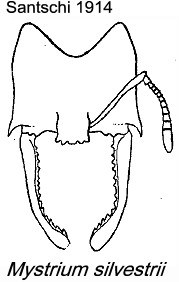Mystrium silvestrii Santschi
  Type location Cameroun (Mystrium Silvestrii, n. sp.,
Santschi,
1914d: 310, illustrated, worker & queen) from Victoria, collector
F. Silvestri, in 1913 Type location Cameroun (Mystrium Silvestrii, n. sp.,
Santschi,
1914d: 310, illustrated, worker & queen) from Victoria, collector
F. Silvestri, in 1913
worker and queen described (see Bolton, 1995)  . .
|
 Santschi's
description (1914d, 310, my translation) is
at Santschi's
description (1914d, 310, my translation) is
at  . .
WORKER - TL 5.8 mm (without the mandibles). Colour dark rust brown.
Anterior of head, mandibles, antennae, legs and gaster of a variable
weak rust. Tarsi and gaster apex yellow. Matt. Head, thorax, petiole
and basal gaster coarsely rugo-reticulate with large hair pits, with an
underlying shiny surface, almost smooth, from which arises a single
short, yellowish, squamose hair. On the base of the gaster the rugae
become longitudinal without forming reticulations, effaced on the rest
of the gaster segments which are finely and densely punctate with the
basal area very finely transversely reticulate. Mandibles, antennae and
femora more superficially rugo-reticulate, overall densely between the
lines, save on the mandibles where the inter-reticulate spaces give
rise to a short, simple hair. in large of gaster. The squamose hairs
are much shorter than in M. voelztkowi Forel (from Madagascar)
and notably more expanded on the body and femora; the hairs are ranged
along the internal border of the mandibles. On the edges of the gaster
the squamose hairs are rather longer and intermingled with long narrow
hairs. The tarsae are spiny on the outer margins. Pubescence short,
slender, sparse except on the funiculus.
Head wider than long, strongly scalloped posteriorly, sides convex
behind and concave anteriorly, terminating anteriorly with two strong
spines longer than in M. voelkztkowi. Vertex with a fairly deep
depression. Eyes very small (smaller than in M. mysticum Roger,
from Madagascar) and almost at the mid-point of the sides. Clypeus
slightly longer and less abrupt than M. mysticum, anterior
equally arcuate and denticulate. Scape just surpassing the midpoint of
the sides of the head. Segments 9 and 10 of the funiculus narrower than
long, segment 11 less than a quarter long than wide. Extremity of
mandibles distinctly spatulate, more enlarged than in mysticum
and voelztkowi. The teeth are smaller, with an upper range of
about 11 reaching almost to the apex where the teeth are very low and
very elongated. The thorax narrows about the mesonotum which is
distinctly short from front to back. Pronotum as long as wide in its
posterior third. Propodeum dorsum wider than long, angled at 115° to
the declivity. Petiole node three times wider than long. Gaster
slightly narrowed after the first segment, which is twice as wide as
long. Legs short.
From Cameroun, Victoria, 3 workers and one female; collector F.
Silvestri - the holotype can be seen at http://www.antweb.org/specimen.do?name=CASENT0101135.
Bolton (1973a) noted that this is the sole West African
species, distributed throughout the forest zone, and nesting in soil.
|